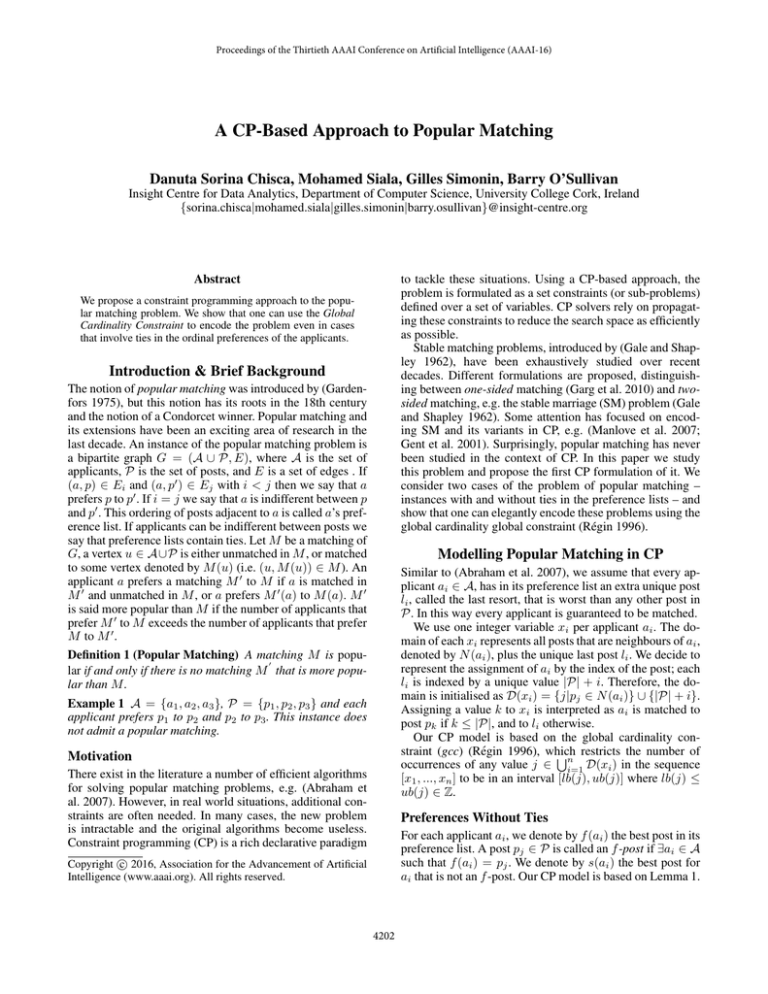
Proceedings of the Thirtieth AAAI Conference on Artificial Intelligence (AAAI-16)
A CP-Based Approach to Popular Matching
Danuta Sorina Chisca, Mohamed Siala, Gilles Simonin, Barry O’Sullivan
Insight Centre for Data Analytics, Department of Computer Science, University College Cork, Ireland
{sorina.chisca|mohamed.siala|gilles.simonin|barry.osullivan}@insight-centre.org
to tackle these situations. Using a CP-based approach, the
problem is formulated as a set constraints (or sub-problems)
defined over a set of variables. CP solvers rely on propagating these constraints to reduce the search space as efficiently
as possible.
Stable matching problems, introduced by (Gale and Shapley 1962), have been exhaustively studied over recent
decades. Different formulations are proposed, distinguishing between one-sided matching (Garg et al. 2010) and twosided matching, e.g. the stable marriage (SM) problem (Gale
and Shapley 1962). Some attention has focused on encoding SM and its variants in CP, e.g. (Manlove et al. 2007;
Gent et al. 2001). Surprisingly, popular matching has never
been studied in the context of CP. In this paper we study
this problem and propose the first CP formulation of it. We
consider two cases of the problem of popular matching –
instances with and without ties in the preference lists – and
show that one can elegantly encode these problems using the
global cardinality global constraint (Régin 1996).
Abstract
We propose a constraint programming approach to the popular matching problem. We show that one can use the Global
Cardinality Constraint to encode the problem even in cases
that involve ties in the ordinal preferences of the applicants.
Introduction & Brief Background
The notion of popular matching was introduced by (Gardenfors 1975), but this notion has its roots in the 18th century
and the notion of a Condorcet winner. Popular matching and
its extensions have been an exciting area of research in the
last decade. An instance of the popular matching problem is
a bipartite graph G = (A ∪ P, E), where A is the set of
applicants, P is the set of posts, and E is a set of edges . If
(a, p) ∈ Ei and (a, p ) ∈ Ej with i < j then we say that a
prefers p to p . If i = j we say that a is indifferent between p
and p . This ordering of posts adjacent to a is called a’s preference list. If applicants can be indifferent between posts we
say that preference lists contain ties. Let M be a matching of
G, a vertex u ∈ A∪P is either unmatched in M , or matched
to some vertex denoted by M (u) (i.e. (u, M (u)) ∈ M ). An
applicant a prefers a matching M to M if a is matched in
M and unmatched in M , or a prefers M (a) to M (a). M is said more popular than M if the number of applicants that
prefer M to M exceeds the number of applicants that prefer
M to M .
Definition 1 (Popular Matching) A matching M is popu
lar if and only if there is no matching M that is more popular than M .
Modelling Popular Matching in CP
Similar to (Abraham et al. 2007), we assume that every applicant ai ∈ A, has in its preference list an extra unique post
li , called the last resort, that is worst than any other post in
P. In this way every applicant is guaranteed to be matched.
We use one integer variable xi per applicant ai . The domain of each xi represents all posts that are neighbours of ai ,
denoted by N (ai ), plus the unique last post li . We decide to
represent the assignment of ai by the index of the post; each
li is indexed by a unique value |P| + i. Therefore, the domain is initialised as D(xi ) = {j|pj ∈ N (ai )} ∪ {|P| + i}.
Assigning a value k to xi is interpreted as ai is matched to
post pk if k ≤ |P|, and to li otherwise.
Our CP model is based on the global cardinality constraint (gcc) (Régin 1996), which
n restricts the number of
occurrences of any value j ∈ i=1 D(xi ) in the sequence
[x1 , ..., xn ] to be in an interval [lb(j), ub(j)] where lb(j) ≤
ub(j) ∈ Z.
Example 1 A = {a1 , a2 , a3 }, P = {p1 , p2 , p3 } and each
applicant prefers p1 to p2 and p2 to p3 . This instance does
not admit a popular matching.
Motivation
There exist in the literature a number of efficient algorithms
for solving popular matching problems, e.g. (Abraham et
al. 2007). However, in real world situations, additional constraints are often needed. In many cases, the new problem
is intractable and the original algorithms become useless.
Constraint programming (CP) is a rich declarative paradigm
Preferences Without Ties
For each applicant ai , we denote by f (ai ) the best post in its
preference list. A post pj ∈ P is called an f -post if ∃ai ∈ A
such that f (ai ) = pj . We denote by s(ai ) the best post for
ai that is not an f -post. Our CP model is based on Lemma 1.
c 2016, Association for the Advancement of Artificial
Copyright Intelligence (www.aaai.org). All rights reserved.
4202
– ∀i ∈ Ω, D(xi ) ← D(xi ) ∩ Ψ;
– ∀i ∈ [1, |A|] \ Ω, D(xi ) ← D(xi ) \ Ψ.
• Let Υ = {i|ai ∈ E}, Θ = {j|pj ∈ E}, Φ = {k|ak ∈ O},
and Λ = {l|pl ∈ O} then
– ∀i ∈ Υ, D(xi ) ← D(xi ) ∩ Λ;
– ∀k ∈ Φ, D(xk ) ← D(xk ) ∩ Θ.
The values of lb(j), and ub(j) are defined as follows: a)
lb(j) = 1, for all j such that pj ∈ O ∪ U , otherwise lb(j) =
0; b) ub(j) = 0 for all j such that ∀ai ∈ A, f (ai ) = pj and
s(ai ) = pj , otherwise ub(j) = 1.
Theorem 2 gcc(lb, ub, [x1 , ..., x|A| ]) is satisfiable iff M is
a popular matching with ties.
Proof. [Sketch] The preprocessing steps enforce the solution
of gcc to be a maximum matching of G1 since every vertex
in O is matched to a vertex in E, and every vertex in U is
matched to another vertex in U .
Lemma 1 (From (Abraham et al. 2007)) A matching M
is popular iff the following conditions hold: Every f post is matched, and for each applicant ai , M (ai ) ∈
{f (ai ), s(ai )}.
Using Lemma 1 we can model the popular matching problem using one gcc constraint. First we reduce the domain of
every variable xi to be exactly {f (ai ), s(ai )}. Next, we define lb(j) and ub(j) as follows: lb(j) = 1 if pj is an f -post,
lb(j) = 0 otherwise; and ub(j) = 0 if ∀ai ∈ A, f (ai ) = pj
and s(ai ) = pj , ub(j) = 1 otherwise.
Theorem 1 gcc(lb, ub, [x1 , ..., x|A| ]) is satisfiable iff M is
a popular matching.
Preferences With Ties
The definition of f (ai ) becomes the set of top choices for
applicant ai . However the definition of s(ai ) is no longer
the same. Indeed it may now contain any number of surplus f -posts. In (Abraham et al. 2007) the authors propose to characterise which f -posts cannot be included in
s(ai ) and exploit the Gallai-Edmonds decomposition. Let
G1 = (A ∪ P, E1 ) where E1 ⊆ E is the subset of edges
corresponding to top choices. Let M be a maximum cardinality matching in G1 . The three set of vertices: even (respectively odd) is the set of vertices having an even (respectively odd) alternating path (with respect to M ) in G1 from
an unmatched vertex; and unreachable is the set of vertices
that are not in even ∪ odd. We denote by E, O, U the sets
of even, odd, and unreachable vertices, respectively. Our CP
model is based on Lemma 2.
Conclusion and Future Research
We proposed a CP formulation for the popular matching
problem which can handle cases in which there are ties in
the applicants’ preference lists. As part of our future work
on this topic we will apply these propositions to solve more
general problems embedding popular matching. An example is the popular matching problem with copies where one
can add additional copies of posts, possibly with an additional cost, in order to find a popular matching if none exists.
The objective is to minimise the total cost of these additional
copies.
Acknowledgement. The Insight Centre for Data Analytics is supported by Science Foundation Ireland under Grant
Number SFI/12/RC/2289.
Lemma 2 (From (Edmonds 1965)) Let E, O, and U be the
vertices sets defined by G1 and M above. Then:
1. {E, O, U} is a partition of A ∪ P and any maximum cardinality matching in G1 leads to exactly the same sets E,
O, and U.
2. Let M be a maximum cardinality matching of G1 . Then,
• Every vertex in O is matched to a vertex in E;
• Every vertex in U is matched to another vertex in U ;
• The size of M is |O| + |U|/2.
3. No maximum cardinality matching of G1 contains an edge
between two vertices in O or a vertex in O and a vertex
in U. Moreover, there is no edge in G1 between a vertex
in E with a vertex in U .
References
Abraham, D. J.; Irving, R. W.; Kavitha, T.; and Mehlhorn,
K. 2007. Popular matchings. SIAM J. Comput. 37(4):1030–
1045.
Edmonds, J. 1965. Paths, trees, and flowers. Canad. J. Math.
17:449–467.
Gale, D., and Shapley, L. S. 1962. College admissions
and the stability of marriage. The American Mathematical
Monthly 69:9–15.
Gardenfors, P. 1975. Match making: Assignments based on
bilateral preferences. SRBS 20:166–173.
Garg, N.; Kavitha, T.; Kumar, A.; Mehlhorn, K.; and Mestre,
J. 2010. Assigning papers to referees. Algorithmica
58(1):119–136.
Gent, I. P.; Irving, R. W.; Manlove, D.; Prosser, P.; and
Smith, B. M. 2001. A constraint programming approach
to the stable marriage problem. In CP 2001, 225–239.
Manlove, D.; O’Malley, G.; Prosser, P.; and Unsworth, C.
2007. A constraint programming approach to the hospitals
/ residents problem. In CPAIOR, Brussels, Belgium, May
23-26, 2007, Proceedings, 155–170.
Régin, J. 1996. Generalized Arc Consistency for Global
Cardinality Constraint. In AAAI’96, 209–215.
So we define s(a) the set of top-ranked posts in a’s preference list that are even in G1 . We use Lemma 3 to model
the popular matching problem with ties.
Lemma 3 (From (Abraham et al. 2007)) A matching M
is popular iff the following conditions hold:
• M ∩ E1 is a maximum matching of G1 ;
• For each applicant ai , M (ai ) ∈ f (ai ) ∪ s(ai ).
We can model the popular matching problem with ties using one gcc constraint. First, the domain is pruned with
D(xi ) ← f (ai ) ∪ s(ai ) ∀i ∈ [1, |A|]. Next, from Lemma 2
we apply the following preprocessing steps:
• Let Ω = {i|ai ∈ U}, and Ψ = {j|pj ∈ U}, then
4203




